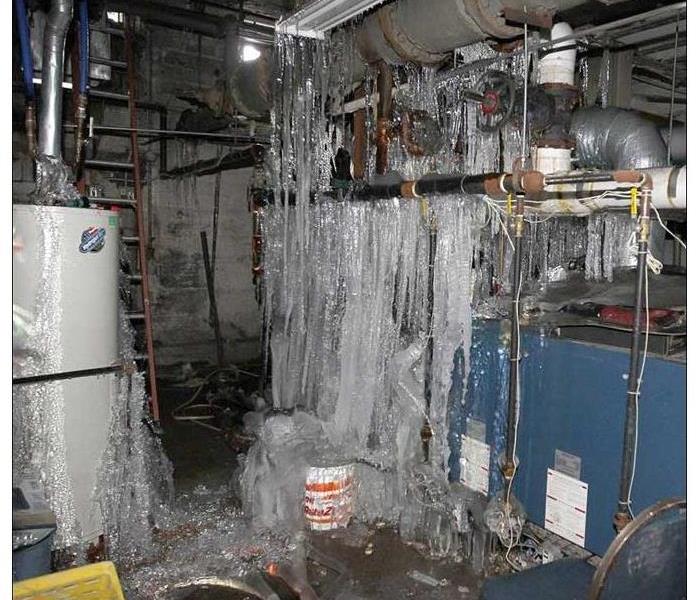Frozen Pipes, how to prevent and how to deal
12/1/2017 (Permalink)
What is worse than a major home maintenance disaster? Try several major home maintenance disasters… at once. When a house’s water pipes freeze, the situation is not as simple as calling a plumber, an 1/8-inch crack in a pipe can spew up to 250 gallons of water a day, causing flooding, serious structural damage, and the immediate potential for mold.
Frozen water pipes are a problem in both cold and warmer climates, affecting quarter-million families each winter, and it can happen in homes with both plastic and copper pipes. It’s all too common, especially considering this damage is largely preventable.
In addition to taking the usual preventive precautions, here are a few steps you can take to keep your pipes from turning frigid nights into inconvenient, and expensive ordeals.
Before winter arrives
The three central causes of frozen pipes are quick drops in temperature, poor insulation, and thermostats set too low. You can prepare you home during the warmer months.
- Insulate pipes in your home’s crawl spaces and attic, even if you live in a climate where freezing is uncommon. Exposed pipes are most susceptible to freezing. Remember, the more insulation you use, the better protected your pipes will be.
- Heat tape or thermostatically controlled heat cables can be used to wrap pipes. Be sure to use products approved by an independent testing organization, such as Underwriters Laboratories Inc. and only for the use intended (exterior or interior). Closely follow all manufacturers’ installation and operation instructions.
- Seal leaks that allow cold air inside near where pipes are located. Look for air leaks around electrical wiring, dryer vents, and pipes, and use caulk or insulation to keep the cold out. With severe cold, even a tiny opening can let in enough cold air to cause the pipe to freeze.
- Before winter hits, disconnect garden hoses and, if possible, use an indoor valve to shut off and drain water from pipes leading to outside faucets. This reduces the chance of freezing in the short span of pipe just inside the house.
When the mercury plummets
Even if you’ve taken the right preventative steps, extreme weather conditions can still harm your pipes. Here are a few more steps you can take:
- A trickle of hot and cold water might be all it takes to keep your pipes from freezing. Let warm water drip overnight, preferably from a faucet on an outside wall.
- Keep your thermostat set at the same temperature during both day and night. You might be in the habit of turning down the heat when you’re asleep, but further drops in the temperature – more common overnight – could catch you off guard and freeze your pipes.
- Open cabinet doors to allow heat to un-insulated pipes under sinks and appliances near exterior walls.
Before you skip town
Travelling in the winter months might be good for the soul, but don’t forget to think about your pipes before you leave. Here are a few things you can do:
- Set the thermostat in your house no lower than 55°F (12°C)
- Ask a friend to check on your house daily to make sure it’s warm enough to prevent freezing.
- Shut off and drain the water system (winterize).
If your pipes do freeze
What if your pipes still freeze, despite your best preventive measures? First step: Don’t panic. Just because they are frozen doesn’t mean they’ve already burst. Here’s what you can do:
- If you turn on your faucet and nothing comes out, leave the faucets turned on and call a plumber.
- Don’t not use electrical appliances in areas of standing water. You could be electrocuted.
- Never try to thaw a pipe with a torch or other open flam because it could cause a fire hazard. Water damage is preferable to burning down your house!!
- You may be able to thaw a frozen pipe with a hair dryer. Start by warming the pipe as close to the faucet as possible, warming toward the coldest section of pipe.
- If your water pipes have already burst, turn off the water at the main shutoff valve in the house; leave the water faucets turned on. Make sure everyone in your family knows where the water shutoff valve is and how to open and close it.




 24/7 Emergency Service
24/7 Emergency Service
